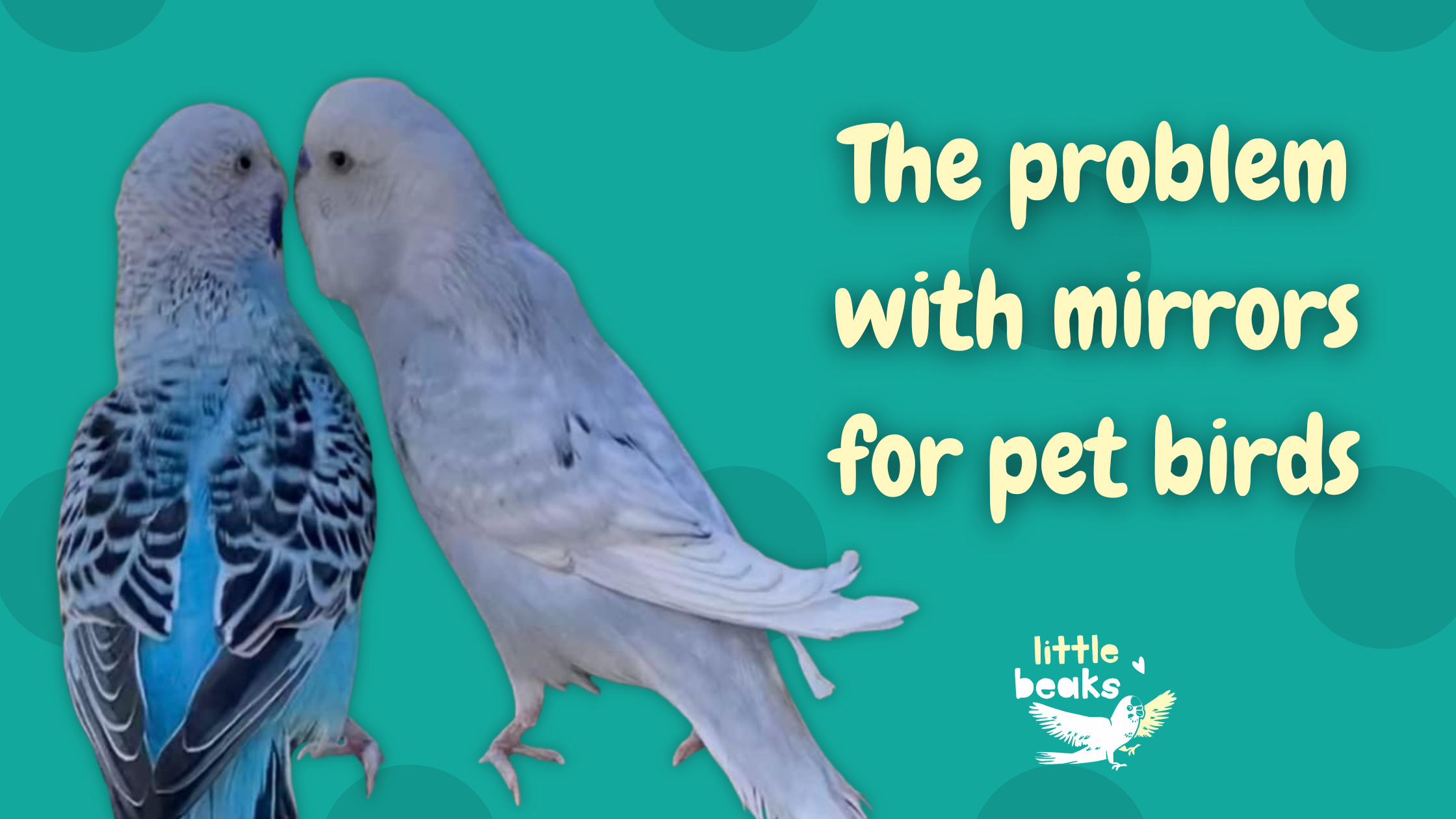Are Mirrors Good for Pet Birds?
Mirrors have long been sold as standard accessories for small pet birds like budgies, cockatiels, and canaries. Many cages in pet stores even come with a mirror already installed. But are they really a good idea?
Many birds do fine with mirrors, especially when the have other birds for company. But it’s important to know the potential risks mirrors can bring for pet birds, especially those kept alone. Why take the risk when there are safer, healthier enrichment options?
A brief history: Why mirrors ended up in bird cages
The practice of putting mirrors in cages became popular in the mid-20th century when keeping small birds as pets surged in Western households. At the time, mirrors were marketed as a way to “keep a lone bird company” and provide “entertainment” in otherwise bare cages. They were cheap, easy to sell, and seemed like a harmless solution—especially when there was little public awareness of birds’ social and emotional needs.
But what we know now is different.
Birds do not recognise themselves in mirrors. Instead, they often see the reflection as another bird, leading to confusion, frustration, and even health problems.
Do any birds recognise themselves in mirrors?
Mirror self-recognition (MSR) is a rare cognitive ability requiring advanced self-awareness. Most animals, including most birds, do not have it.
The European magpie (Pica pica) is the only bird species that has consistently demonstrated mirror self-recognition in scientific studies, passing what’s called the mark test—indicating the magpie understood the reflection was itself, not another bird.
While some parrots and corvids (crows, ravens) show advanced cognition, pet birds like budgies, cockatiels, and canaries do not recognise themselves in mirrors and interpret the reflection as another bird, which can lead to stress, aggression, or hormonal issues.
Why mirrors can harm birds
False companionship
Birds may believe the reflection is another bird, trying to bond with it or even fight it, leading to confusion and stress.
Can trigger chronic egg laying
For female birds, a mirror can act like a perceived “mate,” triggering hormonal surges that lead to chronic egg laying—a condition that can cause calcium depletion, egg binding, and serious health risks.
Aggression and frustration
Some birds become territorial over their mirror, while others grow distressed when the reflection never responds correctly. This can lead to biting, screaming, or feather plucking.
Prevents real connection
Instead of bonding with human caregivers or real bird companions, a bird may fixate on the mirror, missing opportunities for healthy socialisation.
Why do pet shops continue to sell mirrors?
If mirrors are so problematic, why are they still sold everywhere?
Profitability: They are cheap to produce and easy to upsell as cage “toys.”
Outdated beliefs: Mirrors have long been marketed as a way to “keep a lone bird company.”
Lack of education: Many stores are unaware of updated bird welfare research.
Convenience perception: Mirrors appear to be a simple fix for loneliness, even though they often do the opposite.
Industry inertia: Traditional products remain on shelves because they continue to sell, despite no longer being best practice.
In short, mirrors continue to sell because it’s profitable and convenient, not because they are beneficial for birds.
What can you offer instead?
Birds are intelligent, social animals who need meaningful enrichment that supports their natural behaviours and emotional wellbeing:
Foraging toys/areas to encourage natural exploration.
Bird-safe barky branches and foliage for beak health and mental stimulation.
Social time with you or a compatible bird companion (with careful introductions).
Auditory and visual enrichment like supervised window watching or soft nature sounds.
These options support your bird’s wellbeing far more effectively than a mirror ever could.
In summary
While mirrors were once seen as an easy fix for a lonely bird, we now know they can do more harm than good. Birds deserve enrichment that respects their instincts and supports their emotional health—not a reflection that confuses them or triggers unwanted hormonal and behavioural issues.
At Little Beaks, we believe every bird deserves a life that respects who they are. Removing mirrors and replacing them with safe, meaningful enrichment is a small but powerful step toward giving your bird a happier, healthier life.
References
Association of Avian Veterinarians (AAV). (n.d.). Bird Ownership.
Harrison, G. J., & Lightfoot, T. L. (2005). Clinical Avian Medicine. Spix Publishing.
Hess, L., DVM. (n.d.). Mirrors and Birds.
Meehan, C. L., Garner, J. P., & Mench, J. A. (2003). Isosexual pair housing improves the welfare of young Amazon parrots. Applied Animal Behaviour Science, 81(1), 73-88.
Prior, H., Schwarz, A., & Güntürkün, O. (2008). Mirror-induced behavior in the magpie (Pica pica): evidence of self-recognition. PLoS Biology, 6(8), e202.
Speer, B. L. (2016). Birds for Dummies. Wiley.

